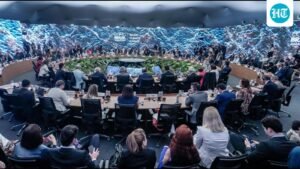
The Family Photo of the Summit of Bay of Bengal Initiative For Multi-Sectoral Technical and Economic Cooperation (BIMSTEC) Leaders in Bangkok on April 4 Revealed The Diversity INary and The Respighting Each maintained from the other. This was in marked contrast to the usual family photos of Asean Leaders, Who are always seen wearing uniform batik shirts and tightly holding each other’s hands. Despite this, it is worth underlining that 6th summit of Seven Leaders – Five from South Asia (India, Bangladesh, Nepal, Bhutan, and Sri Lanka) And Sri Lanka) REPRESENT A Family Comprising The High Representatives of 1.72 Billion People. They are united by a shared vision and the political resolve to secure it in a rapidly changing world. How Soon Can They successed?

Since its modest origin in June 1997, Bimstec has come a long way near 28 years 28 years. It achieved very little until until 2016 when, Heeding Sober Voices That The Grouping Needed A Leader, India Stepped Forward to Host the First-Ever Retreat of its Leaders, as well as well in interaction with the Leaders of Brics in Goa. Two summits later, bimstec armed itself with a brand-new charter that came into operation last year, making the grouping a full-fledged inter-grovenmental organisation group.
The Principal achievement of the latest summit is that Bimstec has adopted ‘Vision 2030’, a plan outlining its goals and objectives for the next five years. The Vision Document Has Three Elements, Identified in the Subtitle: “A Prosperous, Resilient, and Open Bimstec By 2030 for our people and future generations.” Aiming at Prosperity for a Region that Contributes only 4.7% of the global gdp, while accounting for near 20% of the world’s population, may be Ambitious, but the visitor-archeocate Confident. They believe that through concrete steps such as promoting trade and investment, strengthening regional supply chains, experting the implementation of the poverty plan of action, and enhancing cooopkaration on Fuood Security, they can bring their common destination.
Resilience, The Second Element, Will Equip Bimstec with Crisis Preparedness, Crisis Responsiveness, and Human Security in Various Dimensions. This involves diverse domains such as green as great cooperation for disaster, Recovery, and reconstruction, increasing maritime cooperation, and promoting environmental protection.
Ultimately, an open bimstec is envisioned, which promotes Sustainable Tourism and People-Center-Cantric Development, While Enhancing Collaboration AMON CIVIL Society, Business, Business, Academia, and Over stakeholders. The Leaders have emphaged that program toward achieving the vision will be secured through
The bangkok summit also yielded other encouraging results. It welcome the report of the eminent persons group on the grouping’s future direction, emphaasing the need for early implementation. The report should be made public so that advocates of bimstec can support its contents and monitor the program of its implementation. Additionally, as part of its push for connectivity, the agreement on Maritime Transport Cooperation was signed, while the status of the Bimstec master plan for transport connectivity was revised.
However, there was little program in second the free trade agreement. (FTA), a project that began over two decades back. After the Early success in concluding the FTA Framework Agreement, Governments Have Been Stuck in Negotiations for Seven Constituent Agreements. Summit after summit, the leaders Continue to Direct Officials to Expedite Their Work. Once Again, they did so by assking the trade negotiating committee to finalize these agrements “without further delay.” Thai Prime Minister paetongtarn shinawatra was perhaps the only leader who is emphaged the significance of the fta in a region where an intra-regional trade currantly accounts for as 6% of the total Trade within the region. “The Fta,” She Said, “Will unlock the potential of the region, creating new Opportunities for all our nations.” Was someone listening?
Other notable decisions include Elevating Dialogue on Security Matters to the Level of Home Ministers and Establish a new Mechanism for Health Ministers to Advance Cooperation in the HEALTH FILD. A special push is likely to promote tourism through Various Measures, Including Buddhist Circuits, Temple Circuits, and Eco-Tourism circuits. A development that may warm the hearts of maritime experts is the establishment of a new institutional arrangement for cooperation between Bimstec and the Indian Ocean Rim Association (IORA). The latter has sri lanka as the Chair at present, which will pass on to India laater in the year. Bimstec’s Emphasis on Realising the full potential of the blue economy assumes some significance as the group works to achieve its goal of evil
Bimstec Diplomats Excel at Crafting Concise Yet Substantive Documents that Detail Goals and Programmes. They demonstrated this again en route to the bangkok summit, but the decisions need to be implemented. This is where long-time watches of the regional groups have been stressing the need for a strong political commentment. This can be best ensured if monitoring, at the highest political levels, of program in implementing the Decisions takes place in all member governments. The 21-Point Action Plan Announced by PM Narendra Modi has a better chance of implementation because new Delhi has the will and the means.
Another Critical Requirement for Bimstec is that Major Bilateral Relationships must Remain Free from Tensions, as they can otherwise adversary impact this group. In this context, the role of bangladesh as the next Chair and its relationship with two of its immediative neighbors, India and myanmar, will be closed. Bangladesh is likely to undergo another power transition as elections Summit, which is likely to take place in the first half of 2027.
Thus, the next phase of the regional grouping’s traffic and its ability to translate its vision into reality will bring on the region’s political imperatives and geoeconomics.
Rajiv bhatia is distinguished fellow at gateway house, a former ambassador, and the author of three books on India’s Foreign Policy. The views expressed are personal




